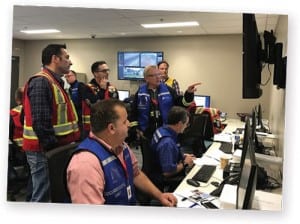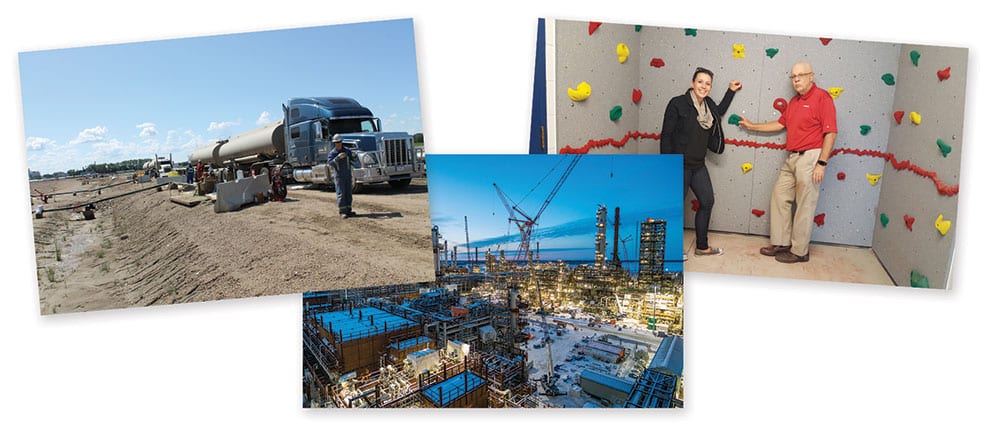Newsletter: Fall 2017
[cs_content][cs_section parallax=”false” separator_top_type=”none” separator_top_height=”50px” separator_top_inset=”0px” separator_top_angle_point=”50″ separator_bottom_type=”none” separator_bottom_height=”50px” separator_bottom_inset=”0px” separator_bottom_angle_point=”50″ style=”margin: 0px;padding: 0px;”][cs_row inner_container=”false” marginless_columns=”false” style=”margin: 0px auto;padding: 0px 0px 20px;”][cs_column fade=”false” fade_animation=”in” fade_animation_offset=”45px” fade_duration=”750″ type=”1/1″ style=”padding: 0px;”][cs_text]
Newsletter: Fall 2017
[/cs_text][/cs_column][/cs_row][cs_row inner_container=”false” marginless_columns=”false” style=”margin: 0px auto 20px;padding: 0px;”][cs_column bg_color=”hsl(0, 0%, 94%)” fade=”false” fade_animation=”in” fade_animation_offset=”45px” fade_duration=”750″ type=”1/2″ style=”padding: 0px 20px;border-style: solid;border-width: 1px;”][cs_text]
Life in the Heartland Overview
Alberta’s Industrial Heartland is Canada’s largest hydrocarbon processing region. Situated northeast of Edmonton, the region’s geographic footprint is 582 square kilometres with industrial zoned land extending into five different municipalities. The region is home to 40+ companies in a variety of sectors, including producing and processing oil, gas, and petrochemicals, as well as advanced manufacturing, with over $35 billion in capital investment to date.
Addressing the interests of residents in Alberta’s Industrial Heartland and ensuring the appropriate communication between stakeholders has long been a priority in the region. Organizations have an extensive history of cooperating and supporting each other in Heartland-related matters. A formal partnership between five local organizations created Life in the Heartland in 2009. The partnership established an improved method of communicating with the community by combining information and resources under one umbrella: Life in the Heartland. This initiative used resident feedback to identify the following as key priority areas:
- Cumulative Effects
- Risk Management
- Air Quality
- Traffic
- Noise
- Water Quality
- Education and Communication
Continued commitment from industry, municipalities, and local organizations brings information on these topics to the community through Life in the Heartland.
Learn more at www.LifeintheHeartland.com.[/cs_text][/cs_column][cs_column bg_color=”rgb(25, 117, 113)” fade=”false” fade_animation=”in” fade_animation_offset=”45px” fade_duration=”750″ type=”1/2″ style=”padding: 20px;color: #fff;”][x_image type=”none” src=”https://porous-chickens.flywheelsites.com/wp-content/uploads/2017/10/photo_newsletter_201710_information_evening.jpg” alt=”” link=”false” href=”#” title=”” target=”” info=”none” info_place=”top” info_trigger=”hover” info_content=””][cs_text style=”color: #fff;”]
New Chair of Life in the Heartland – Tracey Hill
Tracey Hill joins Life in the Heartland as Chair, filling a spot vacated by Vanessa Goodman. Tracey is currently Manager of Communications and Community Relations for Alberta’s Industrial Heartland Association. Tracey has a wealth of experience in communications, including public relations, social media engagement, brand establishment, marketing & promotion as well as traditional narrative development. She comes to Life in the Heartland with a diverse career ranging from communications management, stakeholder and community engagement, and senior leadership at a variety of entrepreneurial and non-profit organizations.[/cs_text][/cs_column][/cs_row][cs_row inner_container=”false” marginless_columns=”false” style=”margin: 0px auto;padding: 0px;”][cs_column fade=”false” fade_animation=”in” fade_animation_offset=”45px” fade_duration=”750″ type=”1/1″ style=”padding: 0px;”][cs_text style=”padding-bottom: 20px;”]
Redwater Air Monitoring Station Operational in October
A new Fort Air Partnership (FAP) continuous air monitoring station in the Town of Redwater is on schedule to becoming operational next month.
The station will be located in the heart of Redwater at 4704-49 Avenue, just southeast of the Town’s administration building. The station will be moved onto the site in mid-September and is expected to begin collecting data in October.
“The new station will continuously collect and report on the quality of the air in and around Redwater. Having an air monitoring station in Redwater is important because it enables us to better understand the quality of the air on a regional basis, especially where people live,” said Nadine Blaney, FAP’s Executive Director. She noted FAP is working closely with town officials and contractors to ensure the smooth set-up and operation of the station. The Town of Redwater has generously offered not to charge FAP lease costs for the site as it considers the station a benefit to the community.
The Redwater station is one of nine continuous air monitoring stations in Fort Air Partnership’s air monitoring network. FAP currently operates an air monitoring station adjacent to Agrium’s Redwater fertilizer plant. Once the Town of Redwater station is activated, that station will be managed by Agrium. It will no longer be part of FAP’s network.
The new Redwater station will collect data on seven substances including sulphur dioxide, nitric oxide, nitrogen dioxide, oxides of nitrogen, ammonia, particulate matter and hydrogen sulphide, as well as weather information. This information will be available to the public in near real time via FAP’s website live date feed (fortair.org).
Fort Air Partnership monitors the air local residents breathe in and around Alberta’s Industrial Heartland. The collection and reporting on substances that affect air quality is transparent, guided by an expert scientific advisory group, and driven by national and provincial standards.[/x_columnize][/cs_column][/cs_row][cs_row inner_container=”false” marginless_columns=”false” style=”margin: 0px auto 20px;padding: 0px;”][cs_column bg_color=”rgb(25, 117, 113)” fade=”false” fade_animation=”in” fade_animation_offset=”45px” fade_duration=”750″ type=”1/3″ style=”padding: 20px;color: #fff;”][cs_text style=”color: #fff;”]
Fort Air Partnership Vision 2030 Public Consultations
Fort Air Partnership, the organization that monitors the air you breathe, is looking for members of the public to participate in Vision 2030 roundtable discussions this fall about the future growth and development of the non-profit group.
Two sessions will be held:
Redwater
Tuesday, November 21, 2017
Pembina Place Curling Club Lounge
4944 – 53 Street
7:00 PM – 9:00 PM
Lamont
Thursday, November 23, 2017
Lamont County Council Chambers
5303 – 50 Avenue
7:00 PM – 9:00 PM
Please RSVP to Godfrey.huybregts@fortairmail.org or call 780-953-0525 if you are interested in attending one of these sessions.
Every Second Counts: Plan 2 Ways Out Fire Prevention Week is October 8 – 14
In a fire, seconds count. Seconds can mean the difference between escaping safely from a fire or having lives end in tragedy. Everyone needs to have an escape plan.
Here’s what you do:
- Draw a map of your home with all members of your household, showing two exits from each room and the path outside from each exit.
- Practice your home fire drill twice a year. Conduct one at night and one during the day with everyone in your home, and practice using different ways out.
- Teach children how to escape on their own in case you can’t help them.
- Make sure your house number is clearly marked and easy for the fire department to find.
- Close doors behind you as you leave – this may slow the spread of smoke, heat, and fire.
- Once you get outside, stay outside. Never go back inside a burning building.
Check the date on your household smoke detectors and replace after 10 years. It can’t save you if it’s not working.[/cs_text][/cs_column][/cs_row][cs_row inner_container=”false” marginless_columns=”false” style=”margin: 0px auto 20px;padding: 0px;”][cs_column fade=”false” fade_animation=”in” fade_animation_offset=”45px” fade_duration=”750″ type=”1/1″ style=”padding: 0px 20px;border-style: solid;border-width: 1px;border-color: rgb(79, 79, 79);”][cs_text]
Year-to-Date Results Show Local Air Quality Has Been Good Most of the Time
Fort Air Partnership (FAP), the organization that monitors the air local residents breathe, recently released local first and second quarter Air Quality Health Index (AQHI) results. Air quality in and around Alberta’s Industrial Heartland during the first six months of 2017 was quite good.
Five of FAP’s air monitoring stations collect data that is used by the Government of Alberta in the calculation of a daily AQHI, which describes the level of health risk associated with an AQHI level. The higher the index level, the greater the health risks.
From January 1 to June 30, the index at those stations registered low risk readings the vast majority of the time. Lamont County had the highest percentage of low risk readings and Fort Saskatchewan had the least. However all stations were in the low risk category more than 93% of the time. Of the 20,561 monitored hours, only eight reached the AQHI high risk category. Most of these were caused by wintertime inversions.
| Risk Level (% of time in each) | |||||
| Station Name | Hours Monitored | Low | Moderate | High | Very High |
| Bruderheim | 4124 | 99.33% | 0.62% | 0.05% | 0.00% |
| Elk Island | 4065 | 98.13% | 1.85% | 0.02% | 0.00% |
| Fort Saskatchewan | 3922 | 93.32% | 6.63% | 0.05% | 0.00% |
| Gibbons | 4223 | 96.26% | 3.72% | 0.02% | 0.00% |
| Lamont County | 4227 | 99.52% | 0.43% | 0.05% | 0.00% |
Forest fires from British Columbia and elsewhere have negatively affected air quality in recent weeks. Local residents can check the forecast and daily AQHI and a live data feed on a variety of substances on our website. FAP also now posts weekly and quarterly AQHI results for its air monitoring stations.[/cs_text][/cs_column][/cs_row][cs_row inner_container=”false” marginless_columns=”false” style=”margin: 0px auto 20px;padding: 0px;”][cs_column fade=”false” fade_animation=”in” fade_animation_offset=”45px” fade_duration=”750″ type=”1/1″ style=”padding: 0px;”][cs_text style=”padding-bottom: 20px;”]
Drill Involves 4000+ People
Over 4,000 personnel assembled at muster points across the NWR Sturgeon Refinery site in a recent drill[/cs_text][cs_text]

NWR Sturgeon Refinery Emergency Operations Centre
In any emergency, the protection of people, property and the environment – in that order – are the priority. Whether working in an office building, a school or an industrial facility, when an alarm sounds, everyone gathers at designated locations or muster points. If anyone is unaccounted for, emergency responders know they will need to conduct a search. When thousands of people are involved, it’s critical that everyone practices and knows what to do, and for emergency response teams to understand what to expect in advance. Recently, all personnel working at the North West Redwater (NWR) Sturgeon Refinery took part in an accountability drill as part of their transition to full operation.[/cs_text][/cs_column][/cs_row][cs_row inner_container=”false” marginless_columns=”true” bg_color=”rgb(25, 117, 113)” style=”margin: 0px auto;padding: 10px 20px;”][cs_column fade=”false” fade_animation=”in” fade_animation_offset=”45px” fade_duration=”750″ type=”1/3″ style=”padding: 20px;”][cs_text style=”color: #fff;”]
Fall Turnarounds
Regular maintenance ensures the facilities are safe and efficient. Because certain maintenance tasks can’t be done unless production is decreased or stopped altogether, companies must schedule turnarounds on a regular basis. Depending on the facility, a turnaround can last as short as a few days, or up to a month or longer. The following companies are conducting turnarounds this fall:
- Air Liquide Canada
- Agrium Redwater
- Chemtrade Logistics
[/cs_text][/cs_column][cs_column fade=”false” fade_animation=”in” fade_animation_offset=”45px” fade_duration=”750″ type=”1/3″ style=”padding: 20px;color: #fff;”][cs_text style=”color: #fff;”]
Impact of Industrial Activity
Construction and turnarounds generate additional local spending on goods and services. They also create employment, as extra manpower is required to complete these projects.
This added manpower may result in a noticeable increase in traffic on local highways. In some cases, such as the Sturgeon Refinery project, a busing program helps alleviate some of the traffic challenges.[/cs_text][/cs_column][cs_column fade=”false” fade_animation=”in” fade_animation_offset=”45px” fade_duration=”750″ type=”1/3″ style=”padding: 20px;”][cs_text style=”color: #fff;”]
Curious About What You See, Hear or Smell?
Many companies use the UPDATEline to keep the community informed about turnaround and construction activities. Call the UPDATEline at 1.866.653.9959 to access pre-recorded messages about industry activity 24 hours a day.
 [/cs_text][/cs_column][/cs_row][cs_row inner_container=”false” marginless_columns=”false” style=”margin: 0px auto;padding: 0px;”][cs_column fade=”false” fade_animation=”in” fade_animation_offset=”45px” fade_duration=”750″ type=”1/1″ style=”padding: 0px;”][cs_text style=”padding-bottom: 20px;”]
[/cs_text][/cs_column][/cs_row][cs_row inner_container=”false” marginless_columns=”false” style=”margin: 0px auto;padding: 0px;”][cs_column fade=”false” fade_animation=”in” fade_animation_offset=”45px” fade_duration=”750″ type=”1/1″ style=”padding: 0px;”][cs_text style=”padding-bottom: 20px;”]
PROJECT UPDATE: Construction Greater Than 95% Complete
[/cs_text][x_image type=”none” src=” ” alt=”” link=”false” href=”#” title=”” target=”” info=”none” info_place=”top” info_trigger=”hover” info_content=””][cs_text]Refinery wide angle overview at dawn[/cs_text][x_columnize]NWR’s Sturgeon Refinery construction progress continues with top quartile safety statistics project-to-date. With construction now greater than 95% complete, the focus continues to progress from mechanical completion toward safe commissioning, start-up and operations. ‘Goal-Zero’ remains a core value for worker and environmental safety, supplemented by safety-focus campaigns to remind all that the ‘Refinery is Live!’ with hydrocarbons.
” alt=”” link=”false” href=”#” title=”” target=”” info=”none” info_place=”top” info_trigger=”hover” info_content=””][cs_text]Refinery wide angle overview at dawn[/cs_text][x_columnize]NWR’s Sturgeon Refinery construction progress continues with top quartile safety statistics project-to-date. With construction now greater than 95% complete, the focus continues to progress from mechanical completion toward safe commissioning, start-up and operations. ‘Goal-Zero’ remains a core value for worker and environmental safety, supplemented by safety-focus campaigns to remind all that the ‘Refinery is Live!’ with hydrocarbons.
Workforce Numbers Trend Down as Activities Focus on Commissioning and Start Up
The construction workforce continues to trend downward, with a current average of approximately 4,400 workers between day and night shifts. These crews are installing remaining piping components, completing electrical power and heat tracing, insulating, pressure testing, and more. Approximately 400 operational staff and contract personnel continue with their operational readiness activities and training for a safe and efficient start-up.
Demobilization of the large construction cranes on site continues, as does the reduction in highway coaches bringing workers to and from site. There are currently 55 coaches transporting workers for day shift plus 6 coaches for night shift. Routes continue to be re-organized to best suit worker origins as the nature of work progresses.
Hydrocarbons in the Refinery as Many Systems Reach Mechanical Completion
Diesel, synthetic crude oil and diluent have been brought into the tank farm area for commissioning purposes, and product shipment equipment to and from the third-party loading facility has been commissioned. Utility boilers were started in late July, and steam blows have been underway since to commission utility systems throughout the refinery.
Recycling Program Continues to Fund Community Investment
NWR’s Community and Charitable Donations program as funded by construction waste recycling continues with several significant contributions to our local community. The focus remains on seniors programs, educational initiatives, and causes in our local community.
Learn more at www.nwrsturgeonrefinery.com.[/x_columnize][cs_text]
Left to right: diesel offload into tank farm area; process area at dusk; Namao School climbing wall[/cs_text][/cs_column][/cs_row][/cs_section][/cs_content]
